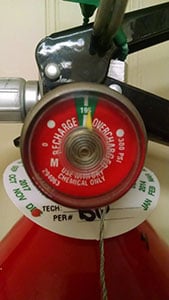Fire Retardant
We tend to think of fire extinguishers as constants — they’re always nearby, ready and waiting in case a fire breaks out. But the truth is that fire extinguishers often are not ready, because they haven’t been properly maintained. There are countless stories of people attempting to fight an incipient-stage fire with a portable extinguisher only to discover too late that the extinguisher is not charged — even if it has never been used before.
Everyone from homeowners to business owners needs to understand the importance of fire extinguisher recharging. This process is an important aspect of fire extinguisher service and maintenance, and cannot be ignored.
When and why do fire extinguishers need to be recharged?
There are several instances where fire extinguisher recharging needs to take place —one that is obvious and some that are less commonly known.
- Fire extinguishers need to be recharged immediately after each use. Even if the extinguishing agent inside was not completely discharged, the extinguisher still needs to be serviced in order to make sure it’s ready for its next use. Even a minimal discharge will normally result in leakage and an eventual total loss of pressure needed for proper operation.
- Fire extinguishers need to be recharged periodically throughout their life, even if they haven’t been used. Both the NFPA 10 code standard for portable fire extinguishers and manufacturer’s service guidelines require periodic internal examination and recharging. For the most commonly used stored pressure dry chemical fire extinguishers, this internal examination and recharging is required at six and twelve years from the date of manufacture noted on the extinguisher.
- Extinguishers can also need to be internally examined or recharged due to damage or other environmental factors that may result in them becoming depressurized.
How to check a fire extinguisher gauge
You should perform a quick fire extinguisher inspection at least once per month, and one of the most important factors to check during this inspection is the pressure gauge. The gauge will tell you whether the unit is undercharged, overcharged, or within the operational zone. You want the needle to point within the green area for optimal use.

What is the fire extinguisher recharging process?
Fire extinguisher recharging should be performed by a trained professional. Fire protection companies have the tools, training and knowledge to ensure that your fire extinguishers are in peak working condition and that they have been properly refilled with the correct extinguishing agent.
Here is what you can expect when your fire extinguisher is recharged. This is not a guide for how to recharge a fire extinguisher, but an overview so that you can understand the process.
- First, the extinguisher is completely depressurized and agent removed from the cylinder.
- The discharge valve is removed from the cylinder.
- The siphon tube is removed from the valve and the valve stem and spring is removed.
- The technician cleans the valve, replaces the valve neck o-ring, and visually inspects the unit internally and externally for signs of damage.
- Once cleaned the valve is reassembled with a new valve stem installed to insure proper seating and avoid future pressure loss.
- The extinguishing agent (water, carbon dioxide, dry chemical, etc.) is refilled by weight to the appropriate amount for the size of the unit and as specified in the recharging instructions for that unit.
- The unit is re-pressurized with the appropriate pressurizing gas and to the required pressure for that unit as noted on the recharging instructions.
- The technician completes a Leak Test to check for signs of leakage and reinstalls the discharge nozzle or hose.
- The extinguisher is weighed again to confirm that the total weight is within allowable tolerances indicated by the manufacturer.
- A new tamper seal is installed on the safety pin and a new recharge tag is attached to the unit with each tag indicating the unit total weight and the identity of the technician completing the work.
One of the simplest ways to help protect your home or business from incipient-stage fires is to ensure your fire extinguishers are properly charged and maintained.
Homeowners: Bring in your fire extinguishers to be recharged and serviced any time, no appointment needed!
Business Owners: Set up fire extinguisher tracking and service with Impact Fire, and our technicians will come to you when it’s time for service — no need to schedule an appointment or remember to bring in your equipment.






